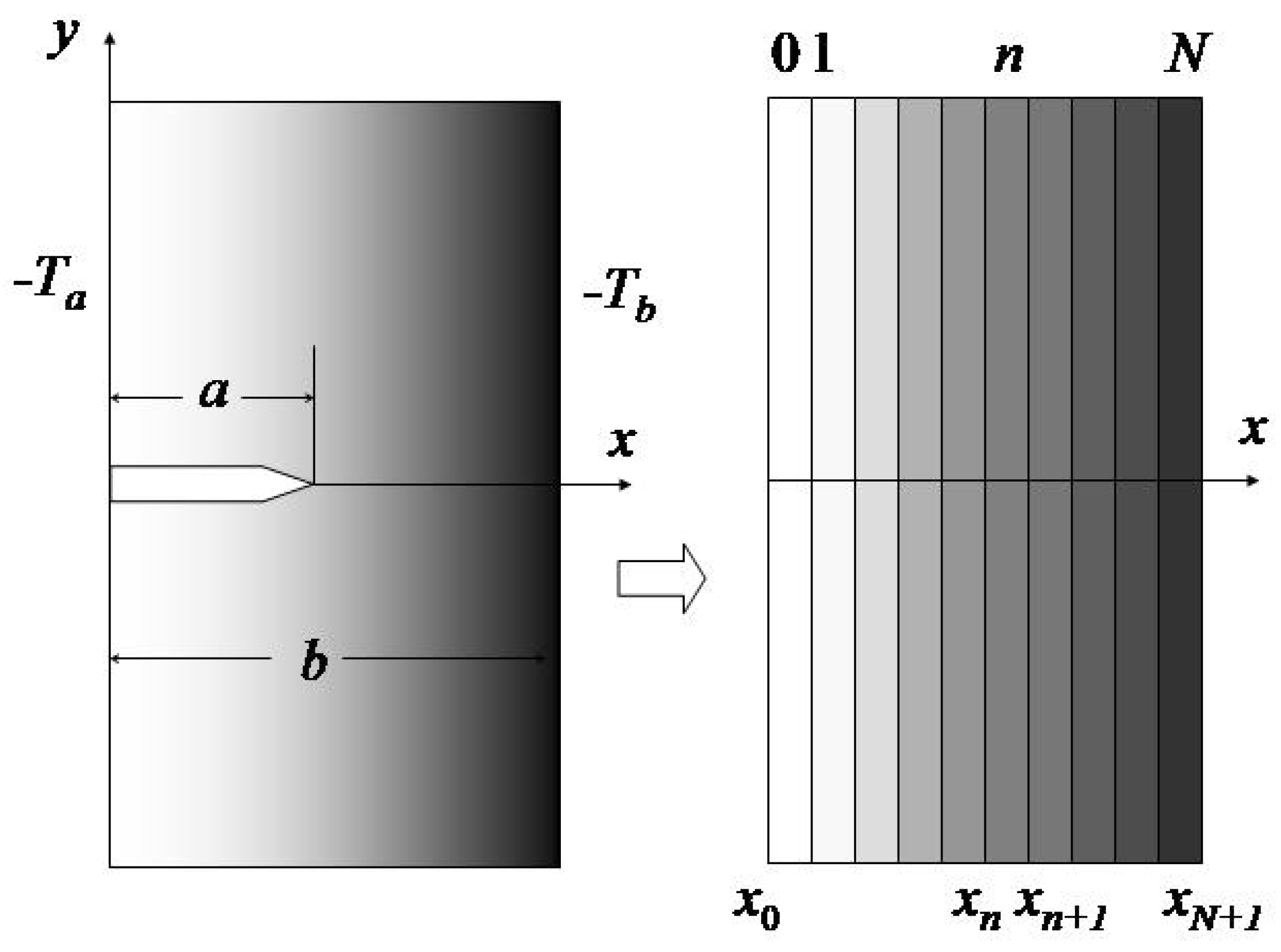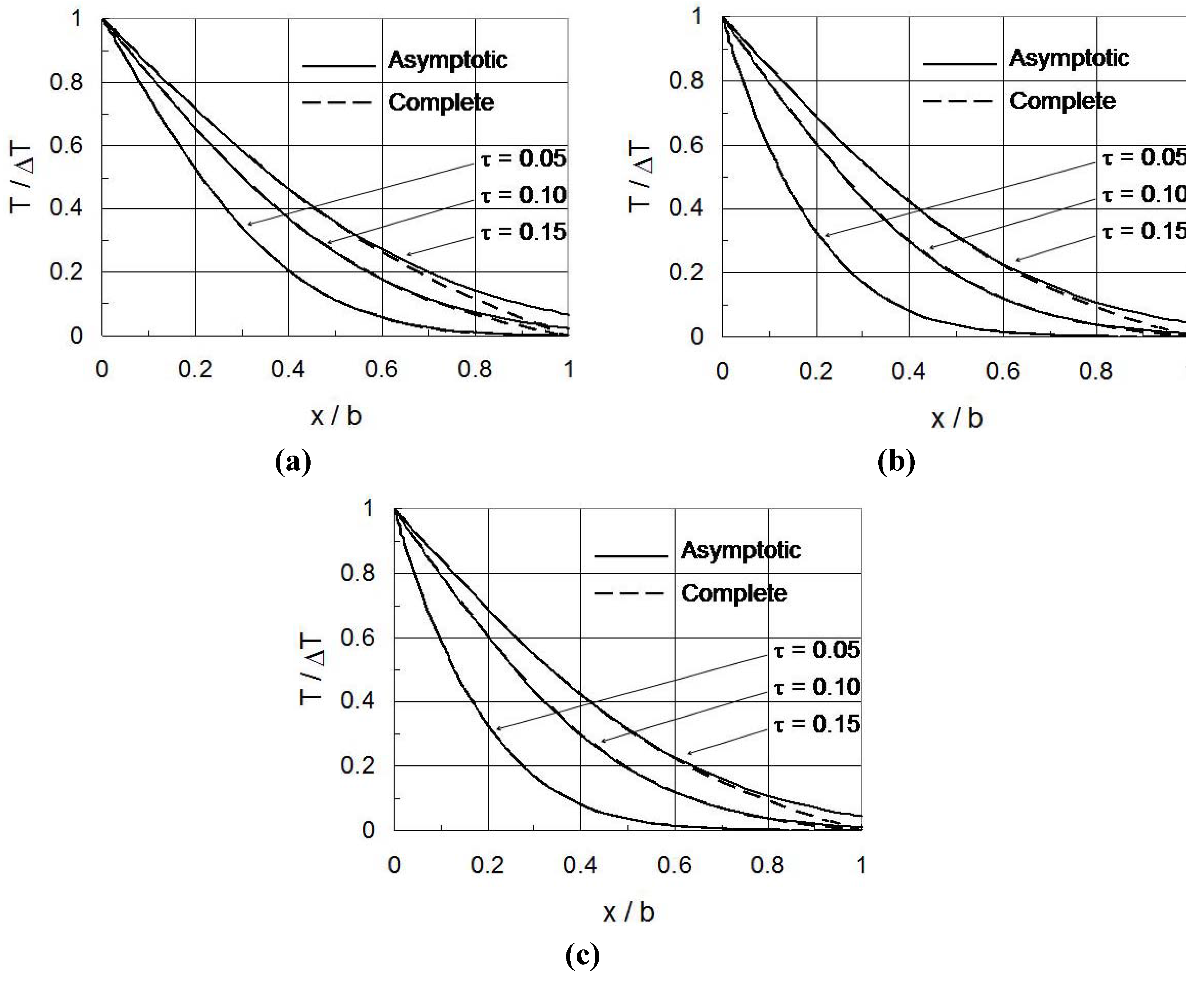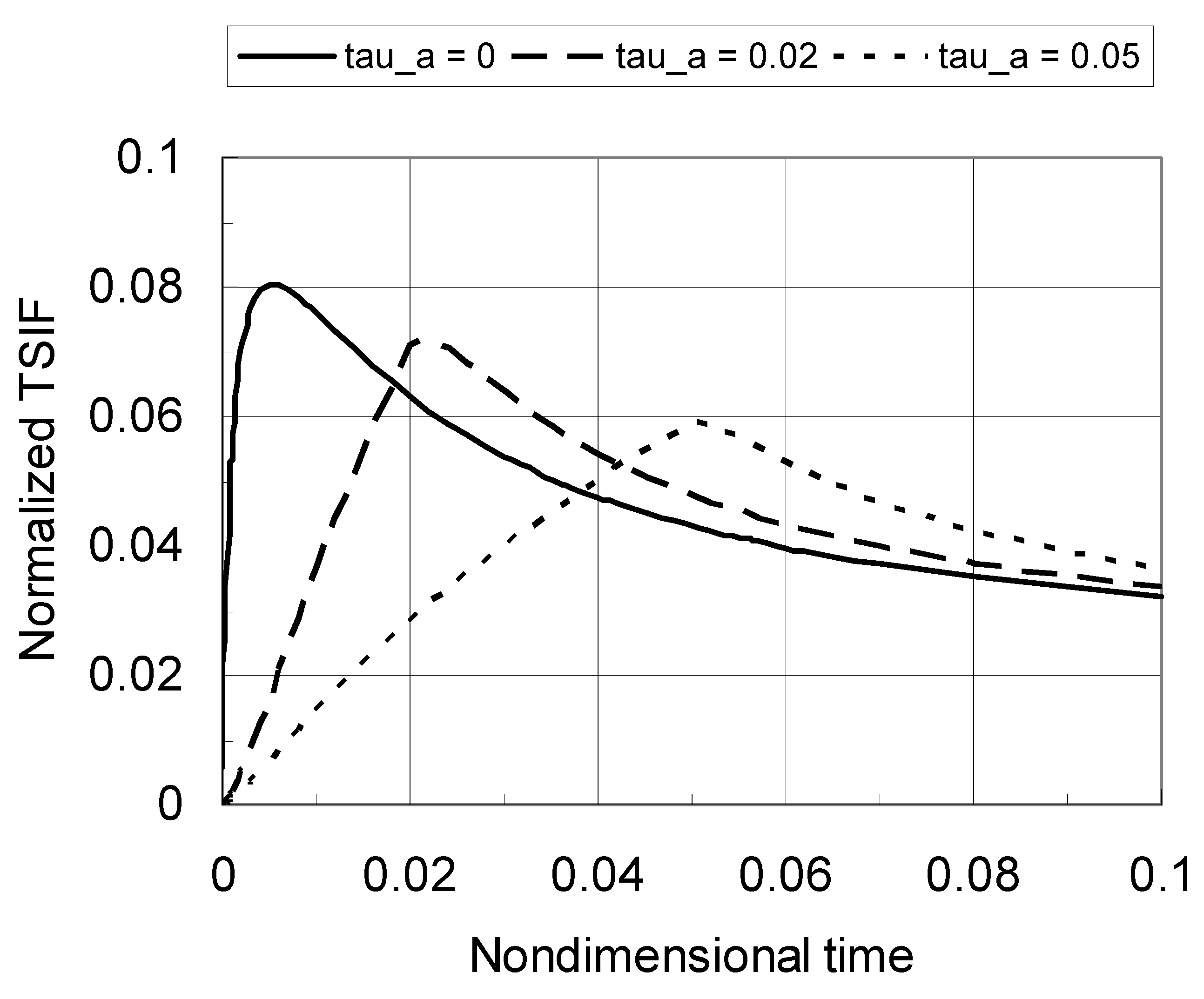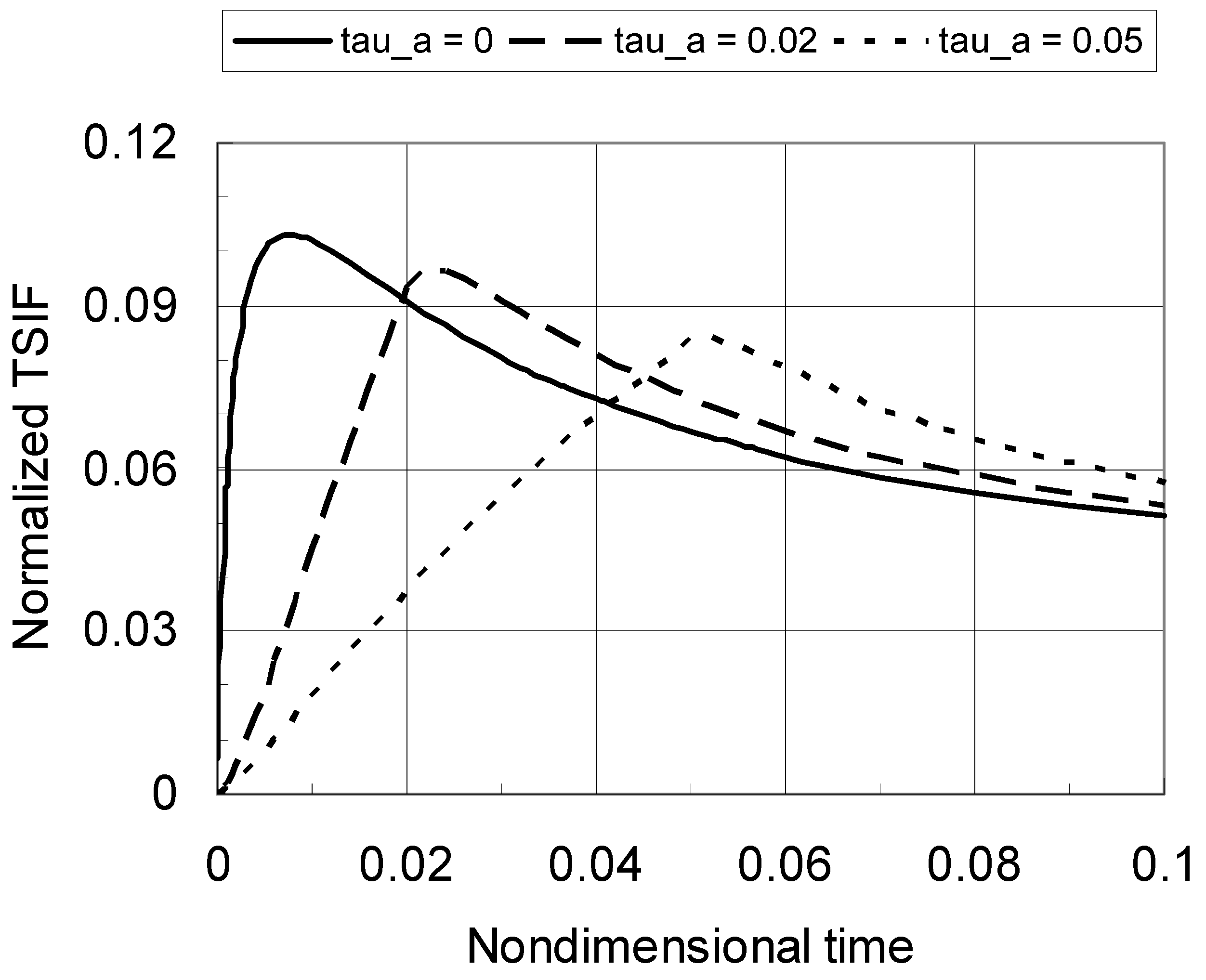1. Introduction
Functionally graded materials (FGMs) represent a new concept of tailoring materials with microstructural and properties gradients to achieve optimized performance. For high-performance structural applications, FGMs are often multi-phased composite materials with the volume fractions of their constituents varying gradually in pre-determined profiles. Thermal loads on FGM structures in high temperature applications induce severe thermal stresses which may lead to failure of the structural components. One of the original objectives of introducing FGMs is to employ the material property gradients to alter the temperature distribution, thereby possibly reducing thermal stresses in thermal structures. The optimal design and thermal stress analyses of FGMs to improve their high temperature and thermal fracture resistance often rely on the transient temperature solution for a long FGM plate with arbitrarily graded material properties in the thickness direction and analytical expressions of the temperature solution are desirable. The temperature field is typically one-dimensional (1-D) in the thickness direction in many structural applications. Obata and Noda [
1] obtained a perturbation solution of 1-D heat conduction in an FGM plate. Ishiguro
et al. [
2] analyzed the 1-D temperature distribution in an FGM strip using a multi-layered material model. Tanigawa
et al. [
3] modeled an FGM plate by a laminated composite with homogeneous layers and obtained the solution of the 1-D temperature field. A layered material model was also used by Jin and Paulino [
4] to obtain an approximate short time solution of temperature field in an FGM strip. In general, the studies based on the multi-layered model involved complicated series form solutions and the series converge very slowly at short times. On the other hand, the temperature solution at short times is particularly useful because thermal stresses and thermal stress intensity factors may reach their peak values in a very short period of time and these peak values govern the thermal stress failure of materials. Jin [
5] obtained a simple closed form short time asymptotic solution of temperature field in an FGM strip with continuous and piecewise differentiable material properties under sudden cooling boundary conditions.
This paper extends the method in [
5] to investigate 1-D heat conduction in an FGM plate with continuous and piecewise differentiable properties subjected to finite cooling/heating rates at the plate boundaries. The rates of temperature variation at the plate surfaces are described by a linear ramp function. A multi-layered material model is first used. The Laplace transform with its asymptotic properties and an integration technique are then employed to obtain a closed form, short time solution of temperature distribution. Finally, the thermal stress intensity factor for an edge crack in the FGM plate is calculated using the asymptotic temperature solution.
2. Basic Equations
Consider an FGM plate of thickness
b as shown in
Figure 1. The material properties of the FGM are graded in the thickness direction (
x – direction). Initially the temperature of the plate is a constant
T0 which can be assumed to be zero without loss of generality. The temperature then gradually changes to −
Ta and −
Tb at the surfaces
x = 0 and
x = b of the plate, respectively. We use a linear ramp function to describe the variations of the boundary temperatures. The initial and boundary conditions for the heat conduction problem are thus
where
T =
T(
x,
t) is the temperature,
t is time, and
ta and
tb are two temporal parameters describing the rates of temperature variation (cooling/heating rates) at the plate surfaces. The one-dimensional heat conduction in the plate is governed by the following basic equation
where
k(
x) is the thermal conductivity,
ρ(
x) the mass density, and
c(
x) the specific heat.
Figure 1.
An FGM plate subjected to a thermal shock and a multi-layered material model.
Figure 1.
An FGM plate subjected to a thermal shock and a multi-layered material model.
3. A Multi-Layered Material Model and the Discrete Temperature Solution
Following Reference [
5], this work employs a multi-layered material model, the asymptotic property of Laplace transform and an integration technique to solve the heat conduction problem described by Equations (1–3). The plate is first divided into
N + 1 layers in the thickness direction, as shown in
Figure 1. The coordinates of the interfaces between the layers are denoted by
xn (
n = 1, 2, …,
N) and the two boundaries of the plate are
x0 = 0 and
xN+1 =
b. When
N becomes large, each layer may approximately be regarded as a homogeneous layer with constant properties
kn (thermal conductivity),
ρn (density),
cn (specific heat), and
κn =
kn/(ρ
ncn) (thermal diffusivity). Let
Tn denote the temperatures at
x =
xn (
n = 0, 1, 2, …,
N+1). The temperature within the
nth layer under the initial condition, Equation (1), has the form [
6,
7]
where
x* and
τ are the nondimensional local coordinate and time defined by
respectively, and
βnl is a constant given by
The unknown interface temperatures Tn(τ) (n = 1, 2, ..., N) are determined from the heat flux continuity conditions across the interfaces.
Substitution of Equation (4) into Equation (7) yields a system of Volterra integral equations for
Tn(
τ). The corresponding Laplace transformed equations have the form:
where
is the Laplace transform of
Tn(
τ). In Equation (8), the nonzero coefficients
amn(
s) have the same expressions as those for sudden cooling conditions (
ta → 0,
tb → 0) in Reference [
5], and
bm(
s) have the forms:
where
τa and
τb are nondimensional temporal parameters defined by
and
Gn(s) are given by
Equation (8) generally does not permit closed form solutions. For large values of
s, however, the Laplace transformed interface temperatures may be obtained as follows
where
and
are the constants given in Reference [
5]. By using the inverse Laplace transform, we can obtain the interface temperatures
Tn(τ) for short times as follows (
τ << 1):
where
and
where
erfc( ) is the complementary error function. We note that the temporal parameters
τa and
τb should also be small,
i.e., the cooling/heating rates are finite but still relatively high.
4. A Closed Form Short Time Solution
In order to obtain a closed form temperature solution for an FGM with continuous and piecewise differential thermal properties from the interface temperatures Equations (13–15), we let the layer thicknesses go to zero and the number of layers go to infinite,
i.e.,
xn+1 –
xn → 0 (
n = 0, 1, 2, …,
N) and
N → ∞. The limits of
and
in Equations (14) and (15) can be found as follows [
5]:
Substituting the equations above into Equations (13–15), we obtain a closed form solution of the temperature field for short times in the FGM plate with continuous and piecewise differentiable properties as follows:
where
and
are given by
and
respectively. In Equations (18) and (19), Ω
1(
x) and Ω
2(
x) are defined by
When
τa and
τb approach zero,
and
reduce to
which are the same as those under the sudden cooling conditions [
5].
Equations (17–20) represent an asymptotic solution of temperature for short times. To gain an understanding of the applicability region in which the asymptotic solution is valid, the asymptotic solution is applied to a homogeneous plate with
Tb = 0 in the boundary condition Equation (2b) by taking
k(
x) =
k0,
c(
x) =
c0,
ρ(
x) =
ρ0 and
κ(
x) =
κ0 in Equations (17–20). The complete solution of temperature in this case is
Figure 2a shows the normalized temperature (where Δ
T = −
Ta)
versus nondimensional coordinate (
x/
b) at various nondimensional time
τ. The temporal parameter
τa is 0.001. The asymptotic solution almost coincides with the complete solution in the entire plate for nondimensional times up to
τ = 0.05. Those solutions are also in good agreement in the region of
x/
b < 0.8 for times up to
τ = 0.10. For times up to
τ = 0.15, the solutions agree well with each other in the region of
x/
b < 0.6. The asymptotic solution approximately satisfies the boundary condition at
x =
b for
τ < 0.05.
Figure 2b and
Figure 2c show similar results when the parameter
τa is increased to 0.05 and 0.1, respectively. It appears that
τa or the rate of boundary temperature variation does not significantly influence the applicability region of the short time solution. It is expected that the short time solution for an FGM plate will also be approximately valid for nondimensional times up to
τ = 0.10 if the material property gradation is not extremely steep.
Figure 2.
Temperature field: asymptotic and complete solutions for a homogeneous plate. (a) τa = 0.001; (b) τa = 0.05; (c) τa = 0.1.
Figure 2.
Temperature field: asymptotic and complete solutions for a homogeneous plate. (a) τa = 0.001; (b) τa = 0.05; (c) τa = 0.1.
5. Effects of Cooling Rate on the Thermal Stress Intensity Factor for an Edge Crack in an FGM Plate
This section uses the asymptotic temperature solution Equations (17–20) to calculate the thermal stress intensity factor (TSIF) for an edge crack in an elastically homogeneous but thermally graded FGM plate (see
Figure 1) and demonstrates that the short time temperature solution can capture the peak TSIF. The integral equation method is employed and the singular integral equation of the crack problem is given as follows:
where
f(
x) is the basic unknown function defined by
with v(
x,0) being the crack surface displacement in the
y direction ,
K(
r, s) is a known kernel [
4],
r and
s are the nondimensional coordinates given by
and
is the thermal stress given by
in which
E is Young’s modulus, ν Poisson’s ratio,
α =
α(
x) the coefficient of thermal expansion, and
θ(
x,
t) =
T(
x,
t) –
T0 the temperature variation.
According to the singular integral equation theory [
8], the solution of Equaion (23) has the following form
where
F(
r) is a continuous and bounded function. Once the solution of Equation (23) is obtained, the TSIF at the crack tip can be computed from
where
KI denotes the TSIF,
K* the nondimensional TSIF, and α
0 = α(0). In Equation (28)
F(1) is a function of time
τ.
We use a TiC/SiC graded system to examine the effects of cooling rate on the TSIF. The FGM is a two-phase composite material with graded volume fractions of its constituent phases. The volume fraction of SiC is assumed to follow a simple power function
where
p is the exponent determining the volume fraction profile. The material properties of the FGM are calculated using conventional micromechanics models [
4] and the properties of TiC and SiC are given in
Table 1.
Table 1.
Material properties of TiC and SiC.
Table 1.
Material properties of TiC and SiC.
| Materials | Young’s modulus
(GPa) | Poisson’s ratio | CTE
(10−6/K) | Thermal
conductivity (W/m-K) | Mass
density (g/cm3) | Specific
heat (J/g-K) |
|---|
| TiC | 400 | 0.2 | 7.0 | 20 | 4.9 | 0.7 |
| SiC | 400 | 0.2 | 4.0 | 60 | 3.2 | 1.0 |
Figure 3 shows the normalized TSIF
versus nondimensional time for various values of the cooling rate parameter
τa. The crack length is
a/
b = 0.1 and the material gradation profile index is
p = 0.2. The TSIF under the sudden cooling condition (
τa = 0, and hence infinite cooling rate) is also included. For a given cooling rate (
Ta/
τa), the TSIF initially increases with time, rapidly reaches the peak value and then decreases with time. The peak TSIF decreases significantly with a decrease in the cooling rate (increasing
τa). Moreover, the time at which the TSIF reaches its peak increases with a decrease in the cooling rate.
Figure 3.
Normalized TSIF versus nondimensional time for a TiC/SiC FGM (a/b = 0.1, p = 0.2).
Figure 3.
Normalized TSIF versus nondimensional time for a TiC/SiC FGM (a/b = 0.1, p = 0.2).
Figure 4 shows the normalized TSIF
versus nondimensional time with an increased material gradation profile index of
p = 0.5. The crack length is still
a/
b = 0.1. Again, the peak TSIF decrease significantly with a decrease in the cooling rate. Comparing the results in
Figure 3 and
Figure 4, one can find that the peak TSIF is reduced by a decrease in the material gradation index
p. Clearly, the peak TSIF occurs at nondimensional times less than 0.1, which indicates that the asymptotic temperature solution can be used to capture the peak TSIF.
Figure 4.
Normalized TSIF versus nondimensional time for a TiC/SiC FGM (a/b = 0.1, p = 0.5).
Figure 4.
Normalized TSIF versus nondimensional time for a TiC/SiC FGM (a/b = 0.1, p = 0.5).








